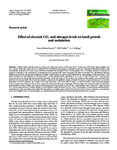Effect of elevated CO2 and nitrogen levels on lentil growth and nodulation
| dc.contributor.author | Nasser, RR | |
| dc.contributor.author | Fuller, Michael | |
| dc.contributor.author | Jellings, AJ | |
| dc.date.accessioned | 2013-02-24T14:50:30Z | |
| dc.date.available | 2013-02-24T14:50:30Z | |
| dc.date.issued | 2008-06 | |
| dc.identifier.issn | 1774-0746 | |
| dc.identifier.issn | 1773-0155 | |
| dc.identifier.uri | http://hdl.handle.net/10026.1/1432 | |
| dc.description.abstract |
Global carbon dioxide levels are rising, and could reach levels of 815 μmol mol−1 by the year 2100. Since photosynthetic rate in C3 species under the current levels of ambient CO2 is still below physiological saturation levels, it is anticipated that photosynthesis and consequently productivity for most crops should be stimulated by the higher levels of atmospheric CO2. A stronger response is expected in legumes as nitrogen is not considered as a limiting factor for growth. This study investigates the effect of elevated CO2 and different nitrogen fertilizer levels on the growth and nodulation of lentils. Syrian lentil was grown under ambient CO2 concentration of 400 μmol mol−1, and under elevated CO2 concentration of 700 μmol mol−1, at five nitrogen levels equivalent to 5, 25, 50, 75 and 100 kg N ha−1. Five harvests were conducted over the growth period and measurements of leaf area index (LAI), biomass dry weight, nodule number, and seed yield at the final harvest were recorded. The results showed that, compared to the ambient control, elevated CO2 led to a significant increase in LAI after flowering (+20–30%), biomass dry weight (+35%) and seed yield (+60%) from 1292.74 kg ha−1 to 2639.55 kg ha−1 at the lowest and highest N levels respectively. Moreover these values increased with increasing levels of nitrogen. Nodule number also increased under elevated CO2 and the highest nodule number was observed at the nitrogen level equivalent to 50 kg N ha−1 under ambient and 75 kg N ha−1 under elevated CO2. The average increase of nodule number for all treatments under elevated CO2 was +52%. Examination of total nitrogen and phosphorus concentrations in the dry matter showed that the total uptake was higher under elevated CO2 but due to the increases in biomass concentration levels were slightly lower. For all parameters, no significant interaction between CO2 and nitrogen treatment was recorded. | |
| dc.format.extent | 175-180 | |
| dc.language | en | |
| dc.language.iso | en | |
| dc.publisher | Springer Science and Business Media LLC | |
| dc.title | Effect of elevated CO2 and nitrogen levels on lentil growth and nodulation | |
| dc.type | journal-article | |
| plymouth.author-url | https://www.webofscience.com/api/gateway?GWVersion=2&SrcApp=PARTNER_APP&SrcAuth=LinksAMR&KeyUT=WOS:000256235500001&DestLinkType=FullRecord&DestApp=ALL_WOS&UsrCustomerID=11bb513d99f797142bcfeffcc58ea008 | |
| plymouth.issue | 2 | |
| plymouth.volume | 28 | |
| plymouth.publication-status | Published | |
| plymouth.journal | Agronomy for Sustainable Development | |
| dc.identifier.doi | 10.1051/agro:2007056 | |
| plymouth.organisational-group | /Plymouth | |
| plymouth.organisational-group | /Plymouth/Faculty of Science and Engineering | |
| plymouth.organisational-group | /Plymouth/Faculty of Science and Engineering/School of Biological and Marine Sciences | |
| plymouth.organisational-group | /Plymouth/REF 2021 Researchers by UoA | |
| plymouth.organisational-group | /Plymouth/REF 2021 Researchers by UoA/UoA06 Agriculture, Veterinary and Food Science | |
| plymouth.organisational-group | /Plymouth/Users by role | |
| plymouth.organisational-group | /Plymouth/Users by role/Academics | |
| dcterms.dateAccepted | 2007-12-03 | |
| dc.identifier.eissn | 1773-0155 | |
| dc.rights.embargoperiod | Not known | |
| rioxxterms.versionofrecord | 10.1051/agro:2007056 | |
| rioxxterms.licenseref.uri | http://www.rioxx.net/licenses/all-rights-reserved | |
| rioxxterms.type | Journal Article/Review |


